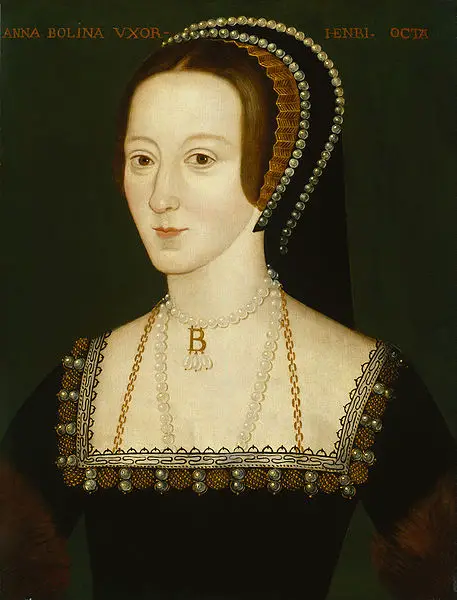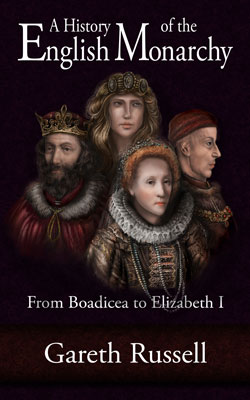December 11
Suitable to be queen?
Extract from A History of the English Monarchy: From Boadicea to Elizabeth I by Gareth Russell

One of the more blithely ridiculous comments often made about Anne Boleyn, even by her legion of modern-day admirers, is that she was unsuited to the office of queen consort. The sexy, sparky, difficult woman who excelled in the role of royal mistress is supposed to have stumbled and fallen at marriage, because she was too confrontational, too glamorous, too brittle and too outspoken. Such an assessment is surely only possible if the writer in question is wholly ignorant of the kind of women who had previously excelled as queens in England. Did the careers of Matilda of Flanders, Isabelle of Angoulême, Eleanor of Castile, Anne of Bohemia or Elizabeth Woodville end in their ruin or execution? Was the entire roll call of this country’s medieval queens consort a bunch of insipid, doe-eyed doormats? Were they not, as Lisa Hilton’s beautiful modern study of them suggests, ‘an exceptional confederacy: magnificent, courageous, foolish, impetuous – splendid in their royal array’?
Katherine of Aragon and Anne Boleyn were the last of the medieval queens consort, the last to be crowned by medieval rituals and the last to exert significant political influence, and in many ways Anne was more than suited to the role she acquired in 1533. She was clever, sophisticated and elegant, she certainly knew how to dress the part, she was extremely generous to charity, and she was adept at interceding for those less fortunate than herself, particularly if they were women. The allegedly difficult aspects of her personality pale in comparison to comparable flaws in queens like Eleanor of Aquitaine, Eleanor of Provence, Isabella of France or Marguerite of Anjou. What brought about Anne Boleyn’s tragic end was not her personality, but her husband’s. No King of England before Henry VIII would ever have been so egotistically self-absorbed as to strike against the mystique of monarchy by publicly executing an anointed Queen, but on 19 May 1536 he did just that.
She was arrested shortly after lunch at Greenwich Palace on 2 May 1536, four months after her second miscarriage. Seven men were accused of being her lovers, including her brother George, Lord Rochford, the King’s closest gentleman-in-waiting, Sir Henry Norris, the athletic playboy Francis Weston, and a young court-based musician called Mark Smeaton, who was of low enough social rank to be tortured into providing evidence against the others. Two of the accused were released with one, Thomas Wyatt, being told at the time of his arrest not to worry, because he would be set free in due course. Their release cleverly made the government’s coup against the Queen seem like a genuine investigation. At her trial, Anne rebutted all the charges at length and held her nerves together, even as she was sentenced to death. The five men were beheaded outside the Tower of London on 17 May and the Queen, her dress defiantly trimmed with ermine, a fur reserved solely for members of the royal family, and protesting her innocence on the Eucharist at her final Mass, was slain two days later. The Archbishop of Canterbury was found weeping hysterically in the grounds of his London palace muttering that Anne would ascend into Heaven and ever since then speculation has run rampant about why Anne Boleyn’s life ended with her kneeling before an executioner.
Historians have ranged from those who believe that Anne’s flirtatious personality gave credence to vicious court rumours to those who support the more traditional interpretation of her demise, namely that her failure to produce a son left her vulnerable to her husband’s tyrannical whims. An attempt in the early 1990s to resurrect the idea that she might actually have been guilty of at least some of the charges foundered on a lack of contemporary evidence, not just in Anne’s defence of herself but also in the prosecution’s clumsy and error-littered case against her. The man who organised the arrests and trials was Thomas Cromwell, the son of a blacksmith from Putney. He had replaced Cardinal Wolsey, his former mentor, as the man Henry VIII could not do without. After the Break with Rome, he had helped co-ordinate the dissolution of the monasteries and ensured that their confiscated wealth was poured into the King’s treasury rather than into socially-improving programmes like new schools and hospitals, which caused Queen Anne to compare him to the Old Testament villain, Haman. Due to this dispute, Cromwell is often accused of framing the Queen before she had him dismissed and selecting her lovers from the list of men who were likely to side with her politically. This is by far the most popular interpretation of what happened to Anne Boleyn in 1536 and there is too much evidence in its support to dismiss it entirely.
However, there is much to be said for the suggestions made by two of Henry VIII’s modern biographers, J. J. Scarisbrick and Derek Wilson, who argue that Cromwell would never have dared move against Anne in such a scandalous and dangerous way had he not been told to, however tacitly, by the King. The pornographic charges against her (the alleged incestuous seduction of her brother was recounted in particularly excruciating detail), the inconsistencies in the prosecution’s case and the nature of her death show far more of Henry’s influence than Cromwell who was, first and foremost, the King’s servant. Henry’s unhinged obsession with his glamorous second wife had reached its tragic finale or, in Professor Scarisbrick’s words, ‘devastating infatuation had turned into bloodthirsty loathing’. Henry, with an ego that was enormous but fragile, destroyed a woman who, with many of the other kings of England, might have made a very successful Queen consort.
Gareth Russell is the author of Young and Damned and Fair, a new biography of Catherine Howard, which The Sunday Times called “a stunning reappraisal” of Henry VIII’s fifth queen. He studied history at Oxford and Queen’s University, Belfast, and he is the author of two novels and four non-fiction books, including A History of the English Monarchy.
